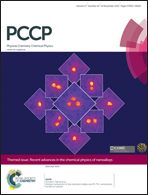Multiscale approach for studying melting transitions in CuPt nanoparticles
Abstract
A multiscale approach, based on the combination of CALPHAD and molecular dynamics (MD) simulation, is applied in order to understand the melting transition taking place in CuPt nanoalloys. We found that in systems containing up to 1000 atoms, the morphology adopted by the nanoparticles causes the icosahedral CuPt to melt at temperatures 100 K below that of the other morphologies, if the chemical composition contains less than 30% of Pt. We show that the solid-to-liquid transition in CuPt nanoparticles of a radius equal to or greater than 3 nm could be studied using classical tools.

- This article is part of the themed collection: Recent advances in the chemical physics of nanoalloys

 Please wait while we load your content...
Please wait while we load your content...